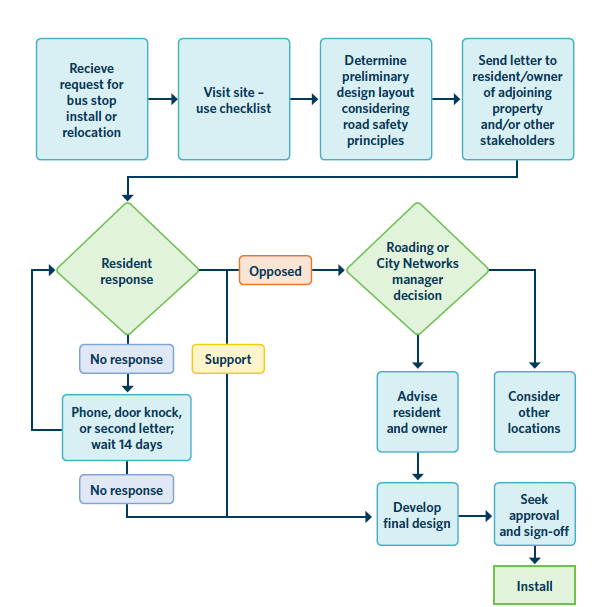There is no specific legislation that requires councils to consult on the location of bus stops.
The consultation principles in the Local Government Act 2002 mean some councils do consult with adjacent property owners and occupiers to understand and consider their views on new or relocated bus stops.
Local Government Act 2002(external link)
Councils may want to consult because altering or introducing a bus stop can be contentious among local residents and business.
Some councils have delegated decision-making about bus stops to local community boards that may be involved in consultation with local residents. Local residents will have various concerns (about actual or perceived problems) but may not understand the full aspects of bus stop technical design operation and safety, or the role of bus stops in the wider transportation network. Therefore, consultation can enable a two-way sharing of information.
A bus stop consultation process with residents or landowners is set out in a flowchart (figure below). It outlines steps for undertaking consultation on bus stops. Although consultation may not be required, it is a useful guide if consultation is undertaken.
It may sometimes be helpful to engage with local disability communities. For more information, see
Disability sector engagement: Good practice guide(external link)
Similarly, local iwi should be consulted for bus stops proposed near marae or other sites important to local iwi. For more information, see
Hononga kit e iwi | our Maori engagement framework

Bus stop consultation process with a resident or owner. (Source: Adapted from Palmerston North City Council Bus Stop Guidelines 2017)
Councils are legally required to consult on ‘transport shelters’. A transport shelter is intended for use by passengers of public transport or small passenger service vehicles. These shelters can be installed on the footpath of any road provided they do not unreasonably prevent access to any land that has frontage to the road provided the consultation requirements are complied with.
The approach outlined the figure above is also relevant when consulting on bus stop shelters. If residents respond with opposition the council can first attempt to mitigate concerns through design, shelter placement, offering boundary fencing or other measures directly relevant to the concerns raised. Should opposition remain, other locations for shelters may be considered, if appropriate (considering the wider public transport network).
The introduction of a bus shelter can be contentious among local residents and businesses. Local residents will have genuine concerns (about real or perceived problems) but may not understand the positive impact of installing a bus shelter on wider transport network outcomes. Therefore, engagement can be an effective way to share and receive information and improve everyone’s understanding.
If the council receives objections to the shelter, a council hearing occurs at which submissions made by (or on behalf of) an objector are considered. The council has discretion to dismiss the objection.
For more information, see the Local Government Act 1974, section 339 Transport shelters(external link)